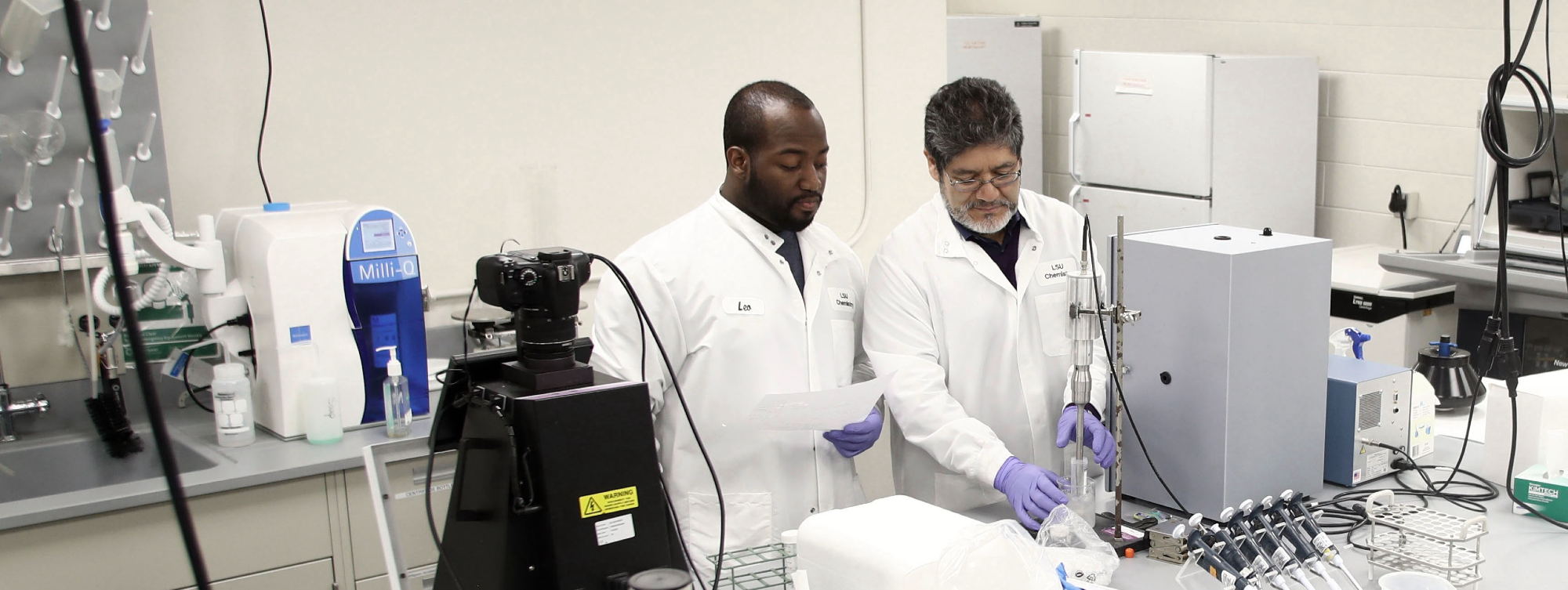Chronic skin wounds are a rising global issue among the elderly, individuals with severe burns, and people with underlying medical diseases such as diabetes. Patients with chronic skin wounds are frequently observed in healthcare settings and long-term care homes, and they suffer from chronic pain and potentially serious infections.
 LSU Chemistry graduate student Leo Fontenot (left) conducting research under the guidance of Professor Mario Rivera (right). Image Credit: Louisiana State University
LSU Chemistry graduate student Leo Fontenot (left) conducting research under the guidance of Professor Mario Rivera (right). Image Credit: Louisiana State University
A biofilm, a colony of bacterial cells encased in a self-produced matrix of extracellular DNA, proteins, and sugar molecules, can make it difficult to treat these wounds effectively. Bacterial cells in biofilms are resistant to the immune system and most commercial antibiotics, which would typically kill free-living, or planktonic, bacteria.
Antibiotic resistance in biofilm bacteria is exacerbated further in biofilm infections involving multidrug-resistant bacteria, or MDR bacteria. As a result, various treatment techniques are required for MDR bacterial biofilm-associated illnesses to be successfully treated.
Mario Rivera, an LSU chemistry professor and the William A. Pryor Chair in Chemistry, recently acquired a five-year $3.69 million NIH R01 grant to devise a new method for killing biofilm-embedded cells and combating biofilm infections caused by MDR bacteria, Pseudomonas aeruginosa, and Acinetobacter baumannii.
The new antibiofilm strategy employs a novel target that disrupts the biofilm’s bacterial iron homeostasis, or the controlled state of intracellular iron. Iron, an essential element for all living beings, is a critical ingredient for most bacterial species’ development and survival. By suppressing a key protein-protein interaction, Rivera’s research team hopes to destabilize bacterial iron homeostasis.
Bacterioferritin (BfrB) is a hollow, spherical protein that can contain hundreds of iron atoms in its core. Rivera and colleagues showed that mobilizing iron contained in BfrB is an important step in bacterial cells that demands BfrB to form a complex with Bfd. The researchers want to break apart the protein-protein connection between BfrB and Bfd.
Researchers also developed solid evidence of small compounds that can inhibit the BfrB-Bfd complex and create an irreversible buildup of useless iron in BfrB, resulting in iron deficiency, metabolic disturbances, and bacterial cell death in the biofilm.
The new grant will support research aimed at turning BfrB-Bfd complex concrete evidence inhibitors into therapeutic lead compounds, which are potent inhibitors that destroy bacteria in biofilms while also having desired drug-like features.
Source:
Journal reference:
Soldano, A., et al. (2021) Small Molecule Inhibitors of the Bacterioferritin (BfrB)–Ferredoxin (Bfd) Complex Kill Biofilm-Embedded Pseudomonas aeruginosa Cells. ACS Infectious Diseases. doi.org/10.1021/acsinfecdis.0c00669.